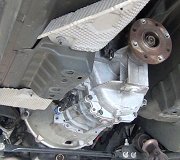Hi,
This is going to be a tricky one to diagnose. The idea that it is showing a 3 mph signal when the vehicle is stopped indicates there is either a short to power or excessive resistance in one of the wires between the VSS and PCM.
Here are the diagnostics that explain how to trouble shoot this type of issue. They are somewhat extensive and require general knowledge of how the electrical system works.
The attached pics are the actual flow chart. Take a look through them and let me know if you are comfortable doing it Also, if you have retrieved a specific code, let me know that as well. It may help narrow things down.
__________________________________________________
2000 Chevy Truck K 1500 Truck 4WD V8-4.8L VIN V
Vehicle Speed Output Circuit Diagnosis
Vehicle Powertrain Management Sensors and Switches - Powertrain Management Sensors and Switches - Computers and Control Systems Vehicle Speed Sensor Testing and Inspection Component Tests and General Diagnostics Vehicle Speed Output Circuit Diagnosis
VEHICLE SPEED OUTPUT CIRCUIT DIAGNOSIS
Vehicle Speed Output Circuit Diagnosis
Diagnostic Chart (Part 1 Of 2)
see pic 1
Diagnostic Chart (Part 2 Of 2)
see pic 2
Schematic
see pic 3
CIRCUIT DESCRIPTION
Various components apply a voltage to the vehicle speed output circuit. The Powertrain Control Module (PCM) creates the vehicle speed output signal by rapidly grounding this circuit via an internal switch called a driver. The driver operates at the same rate as the Vehicle Speed Sensor (VSS) signal input. The various components recognize the voltage being pulled to ground as an indication of vehicle speed.
DIAGNOSTIC AIDS
IMPORTANT: Remove any debris from the PCM connector surfaces before servicing the PCM. Inspect the PCM connector gaskets when diagnosing or replacing the PCM. Ensure that the gaskets are installed correctly. The gaskets prevent water intrusion into the PCM.
For an intermittent, refer to Symptoms. See: Computers and Control Systems > Symptom Related Diagnostic Procedures
TEST DESCRIPTION
The numbers below refer to the step numbers on the diagnostic table.
2. Further circuit diagnosis may require I/P removal. Test the circuit from the PCM to the tachometer for being open, shorted to ground or, voltage.
3. This step is testing for the proper signal voltage.
4. This step is testing for an open circuit between the IPC and connector C100.
5. This step is testing for a grounded circuit between the IPC and connector C100.
6. This step is testing for an open circuit between the PCM and connector C100.
7. This step is testing for a grounded circuit between the PCM and connector C100.
_____________________
Let me know if this helps or if you have other questions.
Take care,
Joe
Images (Click to make bigger)
Thursday, May 6th, 2021 AT 12:23 PM
(Merged)






